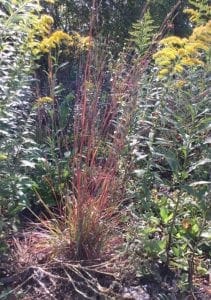

Scientific name: Schizachyrium scoparium
Common name: Little bluestem
Family: Poaceae
Plant type: Grass
Little bluestem (Schizachyrium scoparium; formerly Andropogon scoparius) is a warm-season perennial bunchgrass with attractive foliage. Blue-green in spring and summer, the foliage progresses to a warm blend of golden browns and purplish reds in autumn. The species is widespread across North America and exhibits many ecotypes, depending on growth conditions. Plants generally grow 1-3’ tall, but can reach twice that height, and tend to form dense clumps, 4-10” across. Slender, flat leaves typically range from 8-14” in maximum length. Culms (stems) are erect and solid, branching freely on the upper half. In summer, an arching seedhead, a raceme 1-3” long, appears at the terminus of each branch. The seedheads look white and fuzzy in the sunlight. Each bears many distinct spikelets–some on pedicles (fertile) and others sessile (non-fertile). Fertile spikelets provide food and shelter for many insects. Little bluestem produces copious seeds, and has deep, fibrous roots, making it a good choice for erosion control. It tends to be a second succession plant, meaning that it does not immediately colonize bare, disturbed soil, but comes up after pioneering species are in place. Little bluestem has become rare in much of Georgia, mainly because of the loss of grassland habitat. Fortunately, the species is often used in prairie restorations, and is gaining recognition as a garden plant. Its upright foliage contrasts beautifully with wildflowers in large pollinator plant settings. It likes full sun and fairly dry conditions, and can grow in many soil types.
Credits: Text by Valerie Boss. Photos by Ellen Honeycutt (left, summer foliage) and Valerie Boss (right), autumn foliage).
